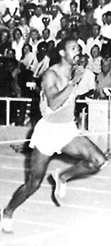 |
John
Carlos
100yd World Record of 9.1
in 1969. |
|
|
ORIGIN
OF TRACK AND FIELD
The
ancient Olympic Games began in the
year 776 BC, when Koroibos, won
the stadium race, a foot race 600
feet long.
From 776 BC, the Games were held in
Olympia every four years for almost
12 centuries. Additional athletic
events were gradually added until,
by the 5th century BC, the religious
festival consisted of a five-day program.
The athletic events included: three
foot races, the pentathlon (five contests:
discus, javelin, long jump, wrestling,
and foot race), pugme (boxing), pale
(wrestling), pankration, and the hoplitodromos.
The marathon is a modern event that
was first introduced in the Modern
Olympic Games of 1896 in Athens, a
race from Marathon to the Olympic
Stadium, a distance of 42.195 kilometers.
The race commemorates the run of Pheidippides,
who carried the news of the Persian
landing at Marathon of 490 BC to Sparta.
The distance of the modern marathon
was standardized as 26 miles 385 yards
or 42,195 kilometers in 1908.
Track and field athletics in the United
States dates from the 1860s. In 1913 American Jim Thorpe was stripped
of his 1912 Olympic victories in the
decathlon and pentathlon and banned
from further competition after it
was learned he had played semiprofessional
baseball. In 1982 the International
Olympic Committee [IOC] posthumously
restored both Thorpe’s amateur
status and his two Olympic medals.
The first NCAA national championships
were held for men in 1921, and women’s
track and field became part of the
Olympic Games in 1928. Over the next 30 years the
U.S. and Soviet teams battled in one
of the sport’s longest and most
competitive rivalries.
The Athletics Congress now regulates
the sport in the United States; the
International Amateur Athletics Federation
(IAAF) sanctions international competition. |


